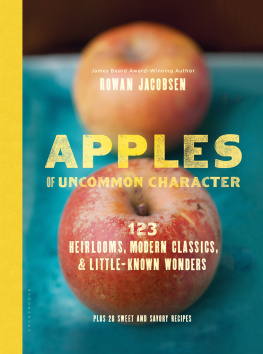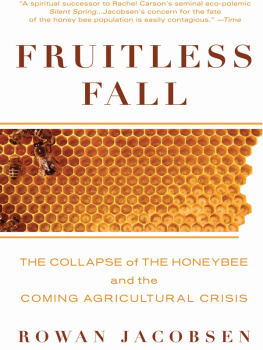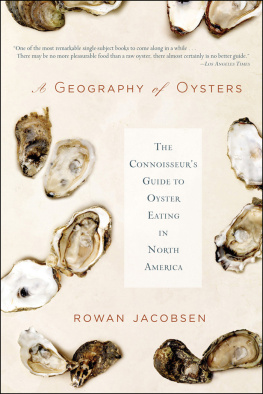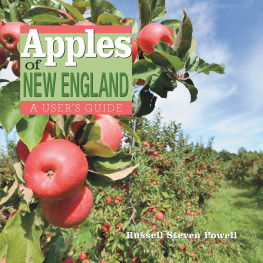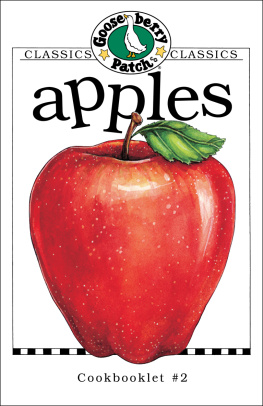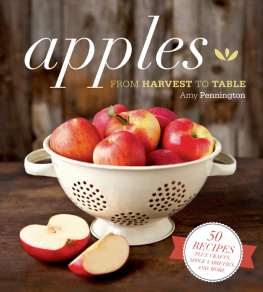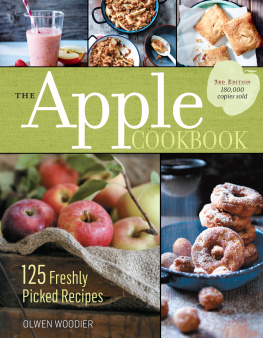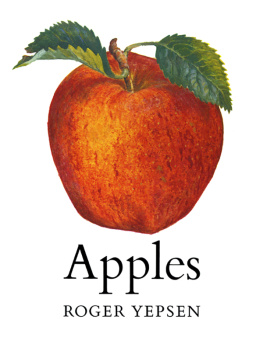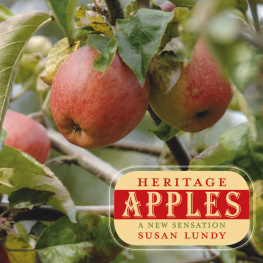

Copyright 2014 by Rowan Jacobsen
Photographs 2014 Clare Barboza
Additional images by Sara Forrest,
Andrea Hubbell, Rowan Jacobsen, and Craig Line
All rights reserved. You may not copy, distribute, transmit, reproduce, or otherwise make available this publication (or any part of it) in any form, or by any means (including without limitation electronic, digital, optical, mechanical, photocopying, printing, recording, or otherwise), without the prior written permission of the publisher. Any person who does any unauthorized act in relation to this publication may be liable to criminal prosecution and civil claims for damages. For information address
Bloomsbury USA, 1385 Broadway, New York, NY 10018.
Published by Bloomsbury USA, New York
Bloomsbury is a trademark of Bloomsbury Publishing Plc.
LIBRARY OF CONGRESS CATALOGING-IN-PUBLICATION DATA
Jacobsen, Rowan.
Apples of uncommon character : 123 heirlooms,
modern classics, and little-known wonders /
Rowan Jacobsen; photographs by Clare
Barboza.-First U.S. edition.
pages cm
Includes index.
eISBN 978-1-63286-035-4
1. Apples-Varieties. I. Barboza, Clare. II. Title.
SB363.3.A1J33 2014
634.11dc23
2013044004
First U.S. edition 2014
This electronic edition published in September 2014
Visit www.bloomsbury.com to find out more about our authors and their books. You will find extracts, author interviews, and author events and you can sign up for newsletters to be the first to hear about our latest releases and special offers.
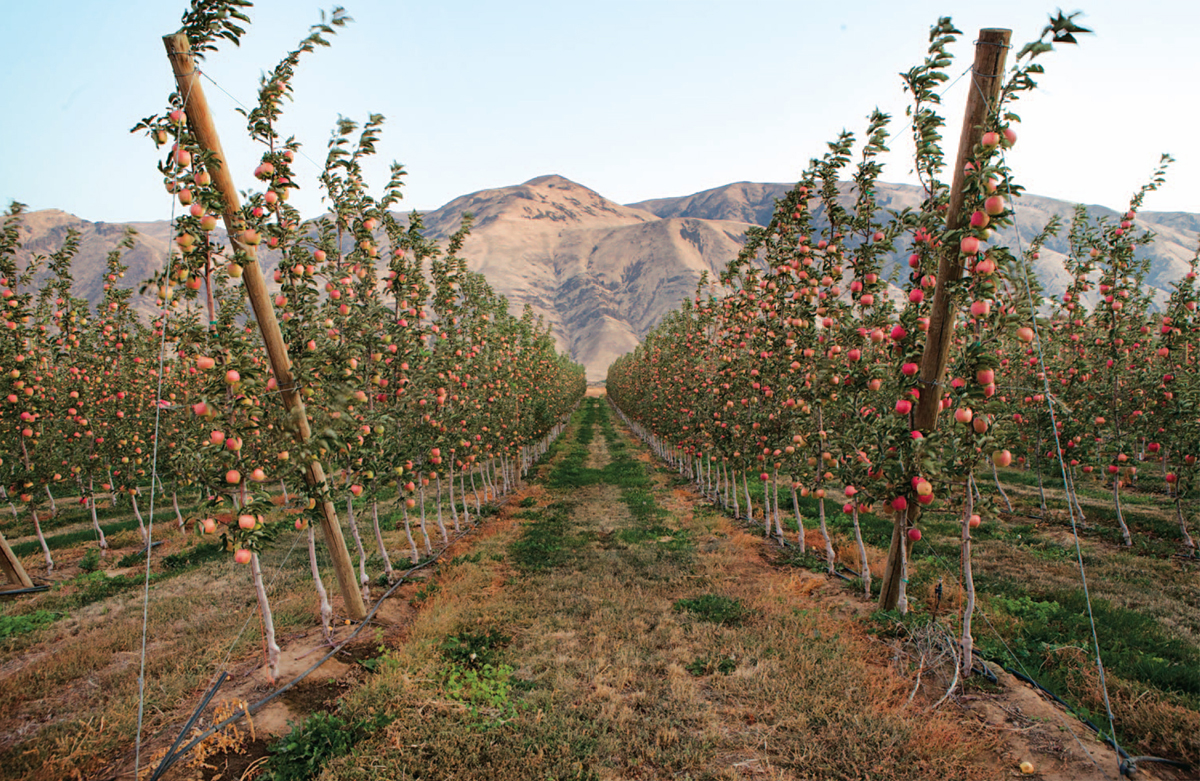
Contents


Ten years ago, my wife and I bought a neglected 1840s farmhouse in Calais, Vermont. For my wife, the attraction was the wide, worn floorboards and the classic Cape lines. For me, it was the four acres of meadows.
Both of us liked the history, the fact that you could look at any of the old maps in the town clerks office and find our little black square with a name penciled beside it: S Laird on the 1858 Beers Atlas; TJ Porter on the 1895. Although we hadnt known any of the previous owners, the sense of continuity was particularly strong on the day in September when we closed on the house. We drove there and walked around, pinching ourselves. It was crisp and sunny, blustery with the first hints of fall, and the line of gnarled trees on the east side of the house was sporting colorful orbs of fruit. Although I hadnt noticed when wed first looked at the house during summer, they were all apple trees.
I grew up in Vermont in the 1970s, where Id learned that the McIntosh was the be-all and end-all of apples. Although it was a clear step up from the Red Delicious and Granny Smith apples in the supermarket, too often it was mushy and rubber-skinned, and Id crossed apples off my life list.
But the apples hanging in these trees didnt look like any Id ever seen in a store. In one tree, they were large, round, and striped red and yellow like little beach balls. In another, they were brown and fuzzy, more like miniature Asian pears than what I thought an apple was supposed to be. I tried one. It was strangely dry, yet very sweet, crunchy, and nutty. A third tree was full of misshapen fruits speckled with red and orange over a background swirl of greens and yellows. I picked one of these, found a relatively unscabby section, and bit into it. Juice exploded into my mouth, fragrant with cinnamon and spice. It was heavenly, and I realized right then and there that Id been missing out.
That fall, driving the back roads of Calais, I began to notice that an extraordinary number of the trees along the roadsides were wild or abandoned apples. Every few hundred yards, the road would be scattered with little green apples, or big yellow ones, or nearly black ones. I took to sampling every tree I could reach. Quite a few were spitters, so sour and astringent that I couldnt even pretend to enjoy them, but a significant minority were not. Some tasted like pineapple, some like anise, and they were so much more interesting than apples Id tasted before that I couldnt believe it. The world was littered with fascinating fruit! Free for the taking! It was as if an apple-centric civilization had passed from existence, and I was living amid the ruins.
Which was, in a sense, exactly what had happened. Apple culture was a huge part of eighteenth- and nineteenth-century American life. There were few national apples, but endless regional ones, each adapted to the local climate and needsiconic apples like Rhode Island Greening and Roxbury Russet in New England; Newtown Pippin in New York and Pennsylvania; Winesap and Hewes Crab in the Southeast; Black Twig and Arkansas Black in the Mississippi River Valley; Ben Davis and Rome Beauty in the Midwest; Sierra Beauty and Gravenstein on the West Coast. Each one had been propagated because it did something superb. Some came ripe in July, some in November. Some held their shape in pies. Some started off hard and sour, but sweetened outrageously after a few months in a root cellar. Some had red flesh so full of tannins that eating one was like biting into a bar of soap, but if you pressed it and let the juice ferment in your basement all winter, it produced a dry, fragrant ciderthe default buzz of agrarian America.
The New York minister and abolitionist Henry Ward Beecher, whose delightful essay on apple pie can be sampled in small servings throughout this book, described a typical mid-nineteenth-century cellar thus: On the east side stood a row of cider barrels; for twelve or twenty barrels of cider were a fit provision for the year,and what was not consumed for drink was expected duly to turn into vinegar, and was then exalted to certain hogsheads kept for the purpose. But along the middle of the cellar were the apple-bins; and when the season had been propitious, there were stores and heaps of Russets, Greenings, Seeknofurthers, Pearmains, Gilliflowers, Spitzenbergs, and many besides, nameless, but not virtueless.
The flavors of these apples ran the gamut, from lemon tart to pumpkin sweet, with lots of citrus, pineapple, and spice notes to bolster that classic apple scent. The shapes and colors were equally diverse. The Black Oxford looked like a plum. The Knobbed Russet looked like the love child of an apple and a toad. The Sheepnose looked like... well, you guessed it.
Where did such diversity come from? To our modern eyes, it all seems suspiciously like the work of some genetic engineer who took the innocent apple genome and slipped in a gene from a strawberry or a clown fish, but in fact all the genetic tinkering was done by the apple itself during its evolutionary journey from the wild forests of Kazakhstan to the fields of Europe and America. The apple has one of the largest genomes of any food plant, and its full of recessive genes and genetic switches. In every apple seed, the genetic deck is reshuffled, new combinations of genes interact in mysterious ways, and many traits that were invisible in the parent may suddenly turn up in the child, or vice versa. What this means is that apples do not come true from seed. If you grow a tree from a McIntosh seed, it will have half the genes of its McIntosh mommy, and half the genes of its mystery dad (delivered as a pollen grain stuck to the hairy body of a bee), but its apples probably wont resemble either parents. The apple may not fall far from the tree, but the next generation of apples will be, genetically speaking, a million miles away. Such seedling trees line the dirt roads, stone walls, cellar holes, and overgrown fields of rural America and rural Englandand have for some time. What I was experiencing along my Vermont roadsides was strikingly similar to observations made by William of Malmesbury, a librarian in an English abbey, in the year 1125: You may see the public highways decked with fruit trees thanks not to art and industry but to the very nature of the soil. The land produces fruit spontaneously, fruit that is far superior to all other in flavor and beauty.

